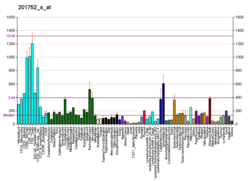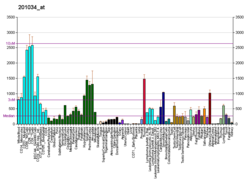Protein-coding gene in the species Homo sapiens
| ADD3 |
|---|
|
| Identifiers |
|---|
| Aliases | ADD3, ADDL, adducin 3, CPSQ3 |
|---|
| External IDs | OMIM: 601568; MGI: 1351615; HomoloGene: 40893; GeneCards: ADD3; OMA:ADD3 - orthologs |
|---|
| Gene location (Human) |
|---|
 | | Chr. | Chromosome 10 (human)[1] |
|---|
| | Band | 10q25.1-q25.2 | Start | 109,996,368 bp[1] |
|---|
| End | 110,135,565 bp[1] |
|---|
|
| Gene location (Mouse) |
|---|
 | | Chr. | Chromosome 19 (mouse)[2] |
|---|
| | Band | 19 D2|19 47.18 cM | Start | 53,140,443 bp[2] |
|---|
| End | 53,247,399 bp[2] |
|---|
|
| RNA expression pattern |
|---|
| Bgee | | Human | Mouse (ortholog) |
|---|
| Top expressed in | - secondary oocyte
- Region I of hippocampus proper
- dorsal motor nucleus of vagus nerve
- corpus callosum
- external globus pallidus
- corpus epididymis
- trigeminal ganglion
- retinal pigment epithelium
- subthalamic nucleus
- caput epididymis
|
| | Top expressed in | - gastrula
- transitional epithelium of urinary bladder
- interventricular septum
- stria vascularis
- granulocyte
- seminal vesicula
- blood
- neural layer of retina
- vestibular membrane of cochlear duct
- atrium
|
| | More reference expression data |
|
|---|
| BioGPS | 

 | | More reference expression data |
|
|---|
|
| Gene ontology |
|---|
| Molecular function | - structural molecule activity
- actin binding
- structural constituent of cytoskeleton
- calmodulin binding
- spectrin binding
- actin filament binding
| | Cellular component | - condensed nuclear chromosome
- cytosol
- plasma membrane
- cell cortex
- cytoskeleton
- membrane
- brush border
- nucleoplasm
- cell-cell junction
- cytoplasm
- postsynaptic density
- plasma membrane raft
| | Biological process | - transmembrane transport
- cytoskeleton organization
- barbed-end actin filament capping
- actin filament bundle assembly
| | Sources:Amigo / QuickGO |
|
| Orthologs |
|---|
| Species | Human | Mouse |
|---|
| Entrez | | |
|---|
| Ensembl | | |
|---|
| UniProt | | |
|---|
| RefSeq (mRNA) | NM_001121
NM_016824
NM_019903
NM_001320591
NM_001320592
|
|---|
NM_001320593
NM_001320594 |
| |
|---|
NM_001164099
NM_001164100
NM_001164101
NM_001277100
NM_013758 |
|
|---|
| RefSeq (protein) | NP_001112
NP_001307520
NP_001307521
NP_001307522
NP_001307523
|
|---|
NP_058432
NP_063968 |
| |
|---|
NP_001157571
NP_001157572
NP_001157573
NP_001264029
NP_038786 |
|
|---|
| Location (UCSC) | Chr 10: 110 – 110.14 Mb | Chr 19: 53.14 – 53.25 Mb |
|---|
| PubMed search | [3] | [4] |
|---|
|
| Wikidata |
| View/Edit Human | View/Edit Mouse |
|
Gamma-adducin is a protein that in humans is encoded by the ADD3 gene.[5][6]
Adducins are heteromeric proteins composed of different subunits referred to as adducin alpha, beta and gamma. The three subunits are encoded by distinct genes and belong to a family of membrane skeletal proteins involved in the assembly of spectrin-actin network in erythrocytes and at sites of cell-cell contact in epithelial tissues. While adducins alpha and gamma are ubiquitously expressed, the expression of adducin beta is restricted to brain and hematopoietic tissues. Adducin, originally purified from human erythrocytes, was found to be a heterodimer of adducins alpha and beta. Polymorphisms resulting in amino acid substitutions in these two subunits have been associated with the regulation of blood pressure in an animal model of hypertension. Heterodimers consisting of alpha and gamma subunits have also been described. Structurally, each subunit is composed of two distinct domains. The amino-terminal region is protease-resistant and globular in shape, while the carboxy-terminal region is protease-sensitive. The latter contains multiple phosphorylation sites for protein kinase C, the binding site for calmodulin, and is required for association with spectrin and actin. Alternatively spliced adducin gamma transcripts encoding different isoforms have been described. The functions of the different isoforms are not known.[6]
References
- ^ a b c GRCh38: Ensembl release 89: ENSG00000148700 – Ensembl, May 2017
- ^ a b c GRCm38: Ensembl release 89: ENSMUSG00000025026 – Ensembl, May 2017
- ^ "Human PubMed Reference:". National Center for Biotechnology Information, U.S. National Library of Medicine.
- ^ "Mouse PubMed Reference:". National Center for Biotechnology Information, U.S. National Library of Medicine.
- ^ Katagiri T, Ozaki K, Fujiwara T, Shimizu F, Kawai A, Okuno S, Suzuki M, Nakamura Y, Takahashi E, Hirai Y (Dec 1996). "Cloning, expression and chromosome mapping of adducin-like 70 (ADDL), a human cDNA highly homologous to human erythrocyte adducin". Cytogenet Cell Genet. 74 (1–2): 90–5. doi:10.1159/000134389. PMID 8893809.
- ^ a b "Entrez Gene: ADD3 adducin 3 (gamma)".
External links
Further reading
- Kaiser HW, O'Keefe E, Bennett V (1989). "Adducin: Ca++-dependent association with sites of cell-cell contact". J. Cell Biol. 109 (2): 557–69. doi:10.1083/jcb.109.2.557. PMC 2115715. PMID 2503523.
- Maruyama K, Sugano S (1994). "Oligo-capping: a simple method to replace the cap structure of eukaryotic mRNAs with oligoribonucleotides". Gene. 138 (1–2): 171–4. doi:10.1016/0378-1119(94)90802-8. PMID 8125298.
- Suzuki Y, Yoshitomo-Nakagawa K, Maruyama K, et al. (1997). "Construction and characterization of a full length-enriched and a 5'-end-enriched cDNA library". Gene. 200 (1–2): 149–56. doi:10.1016/S0378-1119(97)00411-3. PMID 9373149.
- Gilligan DM, Lozovatsky L, Gwynn B, et al. (1999). "Targeted disruption of the β adducin gene (Add2) causes red blood cell spherocytosis in mice". Proc. Natl. Acad. Sci. U.S.A. 96 (19): 10717–22. Bibcode:1999PNAS...9610717G. doi:10.1073/pnas.96.19.10717. PMC 17949. PMID 10485892.
- Citterio L, Azzani T, Duga S, Bianchi G (2000). "Genomic organization of the human gamma adducin gene". Biochem. Biophys. Res. Commun. 266 (1): 110–4. doi:10.1006/bbrc.1999.1769. PMID 10581174.
- Gilligan DM, Sarid R, Weese J (2002). "Adducin in platelets: activation-induced phosphorylation by PKC and proteolysis by calpain". Blood. 99 (7): 2418–26. doi:10.1182/blood.V99.7.2418. PMID 11895774.
- Strausberg RL, Feingold EA, Grouse LH, et al. (2003). "Generation and initial analysis of more than 15,000 full-length human and mouse cDNA sequences". Proc. Natl. Acad. Sci. U.S.A. 99 (26): 16899–903. Bibcode:2002PNAS...9916899M. doi:10.1073/pnas.242603899. PMC 139241. PMID 12477932.
- Gerhard DS, Wagner L, Feingold EA, et al. (2004). "The Status, Quality, and Expansion of the NIH Full-Length cDNA Project: The Mammalian Gene Collection (MGC)". Genome Res. 14 (10B): 2121–7. doi:10.1101/gr.2596504. PMC 528928. PMID 15489334.
- Gocke CB, Yu H, Kang J (2005). "Systematic identification and analysis of mammalian small ubiquitin-like modifier substrates". J. Biol. Chem. 280 (6): 5004–12. doi:10.1074/jbc.M411718200. PMID 15561718.
- Lanzani C, Citterio L, Jankaricova M, et al. (2005). "Role of the adducin family genes in human essential hypertension". J. Hypertens. 23 (3): 543–9. doi:10.1097/01.hjh.0000160210.48479.78. PMID 15716695. S2CID 37253591.
- Yenerel MN, Sundell IB, Weese J, et al. (2005). "Expression of adducin genes during erythropoiesis: a novel erythroid promoter for ADD2". Exp. Hematol. 33 (7): 758–66. doi:10.1016/j.exphem.2005.03.015. PMID 15963851.
- Olsen JV, Blagoev B, Gnad F, et al. (2006). "Global, in vivo, and site-specific phosphorylation dynamics in signaling networks". Cell. 127 (3): 635–48. doi:10.1016/j.cell.2006.09.026. PMID 17081983. S2CID 7827573.



















